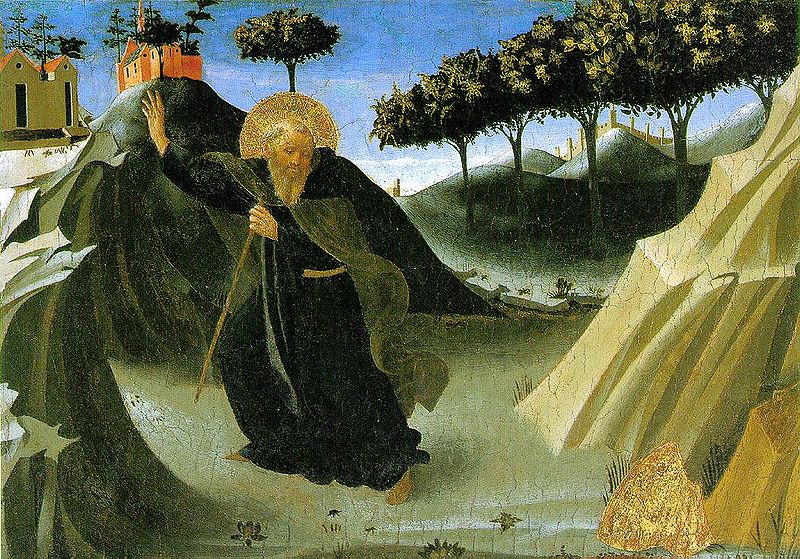
This post has an audio mirror in “To Realize a Commoner Earth”.
It’s time, again, to follow St. Antony into the desert. But what monastery shall we build there? How do our cells, or caves, work?
The monastery is a precedent, preserved in a persistent historical apparatus - architectures, cultural practices, and so on - designed to link the question of how to make oneself, with broader questions about how to make the human world. Rather than say this monastery should be virtual, I’d prefer to say that it should be informational, portable, hyper-local, forkable. Everywhere the internet is, and therefore everywhere capital is, it should be able to exist; it should also be able to exist in places that electronic technologies can’t, haven’t, or shouldn’t penetrate.
Our cells should be similarly understood as nomadic architectures, holons, caves in actual deserts as well as in the “desert of the Real”, hypercaves, where we form, where we go to be consumed back into the earth. The holarchical cell is where we read and write; what we read and write with; what reads and writes us.
In the monastery is the intentional assemblage of people and their cells. It maintains a foundational commitment to working on oneself with negotiated aid from like-minded peers.
What monks tell us even today is that cutting away the frivolous temptations of the world, even if only temporarily, is not done to simplify the spiritual quest, but to amplify it, to allow the deepest psychic demons to rise out in their full, terrible strength. Monks speak of praying while sweeping, chopping wood, serving others at table, and so on. Praxis extended to every breath and silent word. The organizing purpose at the heart of every monastic community, sealed by its architecture, laws, and culture, is then to center this struggle in negotiated support with others.
The centrality of this purpose explains our interest in transposing monastic architectures into the present moment. The system of the world has become a unified ‘stack’ (in Britten’s sense of the word) in service to [what ails us]. We can engage infinitely in describing and analyzing this stack, and designing counter-strategies, but who are we as individuals at the end of the day? How do we become ourselves in spite of - in service of - a ruined planet?
It seems to me that it’s a radical thing to approach with confidence the project of creating a self. If the overhwelming thing now is freedom rather than discipline, then the template of everyone’s struggle is that, confronted with infinite possibilities, what positive statements can be made about what one ‘is’ or ‘should be’ that doesn’t feel like a reinscription of the old gods of discipline and punish? Even beyond the still-useful critique of ‘corporate yoga’ as putting spiritual practice in service to capital, there’s a deeper issue which is that there doesn’t seem to be a more authentic alternative which takes seriously the sustained and arduous project needed to make ourselves better, to our full potential.
But some project must be possible. Some virtues, even. Something like Badiou’s Ethics is exciting because it points to a deeper conversation than what the notion of Ethics currently proposes. But it is still looking outward at society. What is my own face, heart, sex, mind, in a world that is without these kind of ethics yet? What voice and handiwork must I assume, beyond the external-facing project of creating a more just society?
Indeed, the political dimension of the spiritually personal is an important part of two great monastic religions, Christianity and Buddhism, at least in their historical formation; that is, that each represented, in the moment of its arrival, the articulation of a new operating system that consciously sought to create a totally new structure on the earth - in fact a totalizing structure, as in the notion of all Christians being the body of christ on earth - in which co-participants can meet each other as equals around a common general project. Both were radical political and social projects that reimagined how the people of the earth could relate to each other in terms of new protocols and, so to speak, design patterns. What this OS entailed was not so much a list of commandments but an un-language-able principle that, once communicated, could by design translate or render into distinct, contingent ways of being at a local level. Not laws, then, but an ethos or spirit. Not a new code of hammurabi, but a code more like the glider in Conway’s Game of Life; or like DNA itself: a code which contains multitudes, which generates emergent behaviors and properties through complex interaction with other codes…
Today, this is what capitalist realism is: the religion of the age; and the state religion in precisely the way that Roman religion defined the horizon of all life in its day.
So this is what we should seek to build anew: an OS for the self, and for the earth via a network of selves, that provides a manner of interface between us which can help us work toward a greater society, and which, crucially, works for this through formal concern for a kind of governing of the self. Monasteries are the special case of this system in historical precedent, but not the only.
If this praxis should produce anything like formal virtues, my own guess is that they should land at something like this: that the cosmic project of our age is properly one of inventing the control structures to allow a more free and intelligent society for steering our shared life on the earth. The desire for AI or blockchains to govern us is an expression of this - a desire to build angelic lords to take care of us - but shouldn’t we want to struggle a bit to stay at the center of our universe, so to speak?